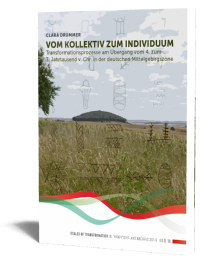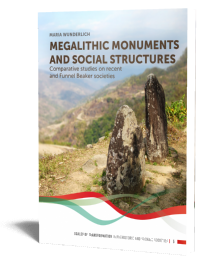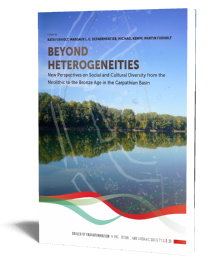Gesellschaft und Monumentalität zwischen Nordatlantik und Ostsee 4500–1800 v. Chr.
Johanna Brinkmann | Forthcoming
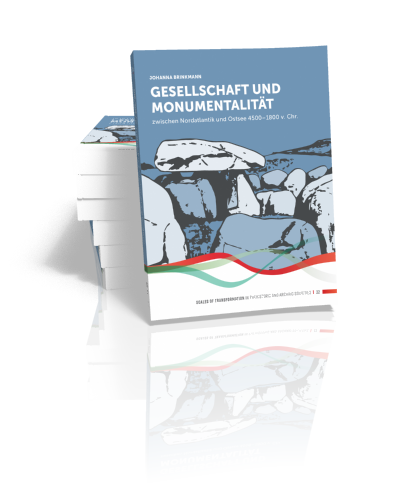
Gesellschaft und Monumentalität zwischen Nordatlantik und Ostsee 4500–1800 v. Chr.
Johanna Brinkmann | Forthcoming
Paperback ISBN: 9789464280999 | Hardback ISBN: 9789464281002 | Imprint: Sidestone Press Dissertations | Format: 210x280mm | ca. 392 pp. | Scales of Transformation 22 | Series: Scales of Transformation | Language: German | 16 illus. (bw) | 28 illus. (fc) | Keywords: neolithic; megalithism; monumentality; integrative archaeology; British Isles; Scandinavia; Northern Germany | download cover | DOI: 10.59641/2s1353ve | CC-license: CC BY 4.0
Publication date: 17-09-2025
-
Digital & Online access
Digital/Online version not (yet) available
-
Buy via Sidestone (EU & UK)
Get €5.00 discount on forthcoming books by using coupon code "PRE-ORDER" in your shopping cart!
-
Buy via our Distributors (WORLD)
For non-EU or UK destinations you can buy our books via our international distributors. Although prices may vary this will ensure speedy delivery and reduction in shipping costs or import tax. But you can also order with us directly via the module above.
For UK & other International destinations
For USA/Canada & other International destinations
-
Bookinfo
Paperback ISBN: 9789464280999 | Hardback ISBN: 9789464281002 | Imprint: Sidestone Press Dissertations | Format: 210x280mm | ca. 392 pp. | Scales of Transformation 22 | Series: Scales of Transformation | Language: German | 16 illus. (bw) | 28 illus. (fc) | Keywords: neolithic; megalithism; monumentality; integrative archaeology; British Isles; Scandinavia; Northern Germany | download cover | DOI: 10.59641/2s1353ve | CC-license: CC BY 4.0
Publication date: 17-09-2025
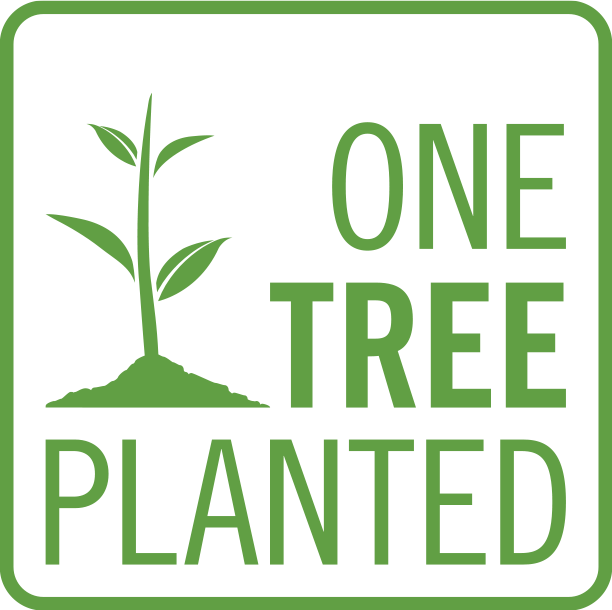
We will plant a tree for each order containing a paperback or hardback book via OneTreePlanted.org.
Kurz vor 4000 v. Chr. erreicht der Neolithisierungsprozess mit den Britischen Inseln und dem westlichen Ostseeraum den Norden Europas. Die Einführung der neuen Subsistenzweise bringt tiefgreifende Veränderungen, zu denen mit einer gewissen zeitlichen Verzögerung auch die Megalithgräber zu zählen sind. Nicht zuletzt wegen ihrer Präsenz in der Landschaft faszinierten diese ikonischen Zeugnisse des Neolithikums zwischen Nordatlantik und Ostsee Forschende bereits vor der Professionalisierung der prähistorischen Archäologie und tun dies bis heute.
Die vorliegende Arbeit bietet erstmals eine zusammenfassende, systematische Darstellung der megalithischen Anlagen sowie der materiellen Kultur des Neolithikums auf den Britischen Inseln und im westlichen Ostseeraum zwischen 4500 und 1800 v. Chr. Eingebettet in einen Vergleich der beweglichen materiellen Kultur (Keramik, Stein- und Metallartefakte), der Siedlungsstrukturen sowie der Gräber und Monumente wird das Auftreten neolithischer Monumentalität in diesem Gebiet verfolgt. Unter Berücksichtigung weiterer Aspekte – wie der Totenbehandlung in Megalithgräbern sowie Subsistenz und Mobilität – zeigen sich Kontinuitäten, Diskontinuitäten und Transformationen. Dabei ist in vielen Aspekten eine parallele Entwicklung zwischen den Britischen Inseln und dem westlichen Ostseeraum erkennbar.
Die systematische Darstellung des Materials baut auf dem hier eingeführten Prinzip der Integrativen Archäologie auf. Den archäologischen Fallstudien vorangestellt ist eine kritische Auseinandersetzung mit dem archäologischen Kulturbegriff, der archäologischen Theoriebildung, der Forschungsgeschichte zur europäischen Megalithik inklusive einer Analyse der vorherrschenden Theorien zur neolithischen Monumentalität.
English abstract
The process of Neolithization reached northern Europe shortly before 4000 BCE spreading to the British Isles and the western Baltic region. The introduction of the new subsistence economy brings with it profound changes, of which the megalithic tombs that appear soon afterwards are probably among the most striking features. Due to their presence in the landscape, these iconic testimonies of the Neolithic between the North Atlantic and the Baltic Sea were a source of fascination even before the professionalization of prehistoric archaeology and continue so today beyond the academic discourse.
This work is the first to offer a summarizing, systematic study of the megalithic sites and the entire material culture of the Neolithic on the British Isles and in the western Baltic between 4500 and 1800 BCE. Embedded in a comprehensive comparative analysis of the movable material culture (pottery, stone and metal artifacts), the settlement structures as well as the graves and monuments, the occurrence of Neolithic monumentality in this area is traced across the entire Neolithic period. On a large-scale level, parallel developments between the British Isles and the western Baltic region are evident in many aspects.
The systematic presentation of the archaeological material is based on the here introduced principle of integrative archaeology. The archaeological case studies are preceded by a critical examination of the concept of archaeological cultures and theory formation in archaeology on the one hand, and a summary of megalithism in the European research history as well as an analysis of the prevailing theories on Neolithic monumentality on the other.
Foreword of the series editors
Vorwort der Autorin
1. Einleitung
2. Theorien in der Archäologie – Verortung, Begrifflichkeiten
2.1 Von Theorien, Interpretationen und impliziten Annahmen
2.2 Jenseits von „Paradigmenwechseln“
2.2.1 Kulturhistorische Archäologie
2.2.2 New Archaeology (Prozessualismus)
2.2.3 Post-Prozessualismus
2.2.4 Von „Paradigmenwechseln“ zu einer Integrativen Archäologie
2.3 Middle-Range Theory
3. Megalithik und Monumentalität
3.1 Megalithik: Von Montelius bis ins 21. Jahrhundert
3.2 Monumentalität
3.3 Theorien zur neolithischen Monumentalität
3.3.1 Territorialität: Renfrews territoriale Marker und ihr Vermächtnis
3.3.2 Soziale Differenzierung und Machterwerb: Gräber für die Lebenden?
3.3.3 Ideologischer Wandel: Mensch, Natur, Umwelt
3.3.4 Kulturelles Gedächtnis: Erinnerungsorte, Kollektivität, Kooperation
3.3.5 Identifizierte Motive in der Interpretation neolithischer Monumentalität
4. Hintergrund
4.1 Arbeitsgebiet
4.2 Chronologie
4.3 Herangehensweise
4.3.1 Klassifikation des Materials: Typen, ‚Leitformen‘ und Kulturbegriff
4.3.2 Kontinuität und Diskontinuität
4.3.3 Transformationen
5. Britische Inseln
5.1 Arbeitsgebiet
5.2 Chronologie
5.3 Bewegliche materielle Kultur
5.3.1 Keramik
5.3.2 Steinartefakte
5.3.3 Metallartefakte
5.4 Haus-, Siedlungs- und Gebäudestrukturen
5.5 Gräber und Monumente
5.6 Totenbehandlung in Megalithgräbern
5.6.1 Direkte Nachweise für genetische Verwandtschaft in Megalithgräbern
5.7 Subsistenz
5.8 Mobilität von Mensch und Tier
5.9 Kontinuitäten und Diskontinuitäten auf den Britischen Inseln 4500–1800 v. Chr.
6. Westlicher Ostseeraum
6.1 Arbeitsgebiet
6.2 Chronologie
6.3 Bewegliche materielle Kultur
6.3.1 Keramik
5.3.2 Steinartefakte
5.3.3 Metallartefakte
6.4 Häuser-, Siedlungs- und Gebäudestrukturen
6.5 Gräber und Monumente
6.6 Totenbehandlung in Megalithgräbern
6.6.1 Direkte Nachweise für genetische Verwandtschaft in Megalithgräbern
6.7 Subsistenz
6.8 Mobilität von Mensch und Tier
6.9 Kontinuitäten und Diskontinuitäten im westlichen Ostseeraum 4500–1800 v. Chr.
7. Gesellschaft und Monumentalität – Diskontinuitäten und Transformationen zwischen Nordatlantik und Ostsee 4500-1800 v. Chr.
7.1 Hauptphasen der Kollektivgrabsitte
7.2 Megalithgräber und Gesellschaftsstruktur
8. Zusammenfassung
9. Summary
10. Literaturverzeichnis
11. Anhang
11.1 Abkürzungen
11.2 Tabellen
Dr. Johanna Brinkmann
Johanna Brinkmann is a postdoc in the ROOTS Cluster of Excellence at Kiel University, where she conducts research about knowledge transfer in the European Bronze Age and the relationship between theory and practice in archaeology. She completed her PhD on Neolithic monumentality at Kiel University in 2023 during which she was part of the ‘CRC 1266 Scales of Transformation’. Johanna studied Pre- and Protohistoric Archaeology in Würzburg and Kiel and was awarded the German Archaeology Study Prize for her Master’s thesis on the energy expenditure of Bronze Age metallurgy. She specializes in the Neolithic and Bronze Age in Northern and Central Europe. The emphasis of her research in the past has been on megalithism and monumentality in North-western Europe as well as the Bronze Age in Central Europe, where she focussed on large-scale analysis of archaeological material, technological aspects of bronze metallurgy and reflectivity in archaeology.
Abstract:
Kurz vor 4000 v. Chr. erreicht der Neolithisierungsprozess mit den Britischen Inseln und dem westlichen Ostseeraum den Norden Europas. Die Einführung der neuen Subsistenzweise bringt tiefgreifende Veränderungen, zu denen mit einer gewissen zeitlichen Verzögerung auch die Megalithgräber zu zählen sind. Nicht zuletzt wegen ihrer Präsenz in der Landschaft faszinierten diese ikonischen Zeugnisse des Neolithikums zwischen Nordatlantik und Ostsee Forschende bereits vor der Professionalisierung der prähistorischen Archäologie und tun dies bis heute.
Die vorliegende Arbeit bietet erstmals eine zusammenfassende, systematische Darstellung der megalithischen Anlagen sowie der materiellen Kultur des Neolithikums auf den Britischen Inseln und im westlichen Ostseeraum zwischen 4500 und 1800 v. Chr. Eingebettet in einen Vergleich der beweglichen materiellen Kultur (Keramik, Stein- und Metallartefakte), der Siedlungsstrukturen sowie der Gräber und Monumente wird das Auftreten neolithischer Monumentalität in diesem Gebiet verfolgt. Unter Berücksichtigung weiterer Aspekte – wie der Totenbehandlung in Megalithgräbern sowie Subsistenz und Mobilität – zeigen sich Kontinuitäten, Diskontinuitäten und Transformationen. Dabei ist in vielen Aspekten eine parallele Entwicklung zwischen den Britischen Inseln und dem westlichen Ostseeraum erkennbar.
Die systematische Darstellung des Materials baut auf dem hier eingeführten Prinzip der Integrativen Archäologie auf. Den archäologischen Fallstudien vorangestellt ist eine kritische Auseinandersetzung mit dem archäologischen Kulturbegriff, der archäologischen Theoriebildung, der Forschungsgeschichte zur europäischen Megalithik inklusive einer Analyse der vorherrschenden Theorien zur neolithischen Monumentalität.
English abstract
The process of Neolithization reached northern Europe shortly before 4000 BCE spreading to the British Isles and the western Baltic region. The introduction of the new subsistence economy brings with it profound changes, of which the megalithic tombs that appear soon afterwards are probably among the most striking features. Due to their presence in the landscape, these iconic testimonies of the Neolithic between the North Atlantic and the Baltic Sea were a source of fascination even before the professionalization of prehistoric archaeology and continue so today beyond the academic discourse.
This work is the first to offer a summarizing, systematic study of the megalithic sites and the entire material culture of the Neolithic on the British Isles and in the western Baltic between 4500 and 1800 BCE. Embedded in a comprehensive comparative analysis of the movable material culture (pottery, stone and metal artifacts), the settlement structures as well as the graves and monuments, the occurrence of Neolithic monumentality in this area is traced across the entire Neolithic period. On a large-scale level, parallel developments between the British Isles and the western Baltic region are evident in many aspects.
The systematic presentation of the archaeological material is based on the here introduced principle of integrative archaeology. The archaeological case studies are preceded by a critical examination of the concept of archaeological cultures and theory formation in archaeology on the one hand, and a summary of megalithism in the European research history as well as an analysis of the prevailing theories on Neolithic monumentality on the other.
Contents
Foreword of the series editors
Vorwort der Autorin
1. Einleitung
2. Theorien in der Archäologie – Verortung, Begrifflichkeiten
2.1 Von Theorien, Interpretationen und impliziten Annahmen
2.2 Jenseits von „Paradigmenwechseln“
2.2.1 Kulturhistorische Archäologie
2.2.2 New Archaeology (Prozessualismus)
2.2.3 Post-Prozessualismus
2.2.4 Von „Paradigmenwechseln“ zu einer Integrativen Archäologie
2.3 Middle-Range Theory
3. Megalithik und Monumentalität
3.1 Megalithik: Von Montelius bis ins 21. Jahrhundert
3.2 Monumentalität
3.3 Theorien zur neolithischen Monumentalität
3.3.1 Territorialität: Renfrews territoriale Marker und ihr Vermächtnis
3.3.2 Soziale Differenzierung und Machterwerb: Gräber für die Lebenden?
3.3.3 Ideologischer Wandel: Mensch, Natur, Umwelt
3.3.4 Kulturelles Gedächtnis: Erinnerungsorte, Kollektivität, Kooperation
3.3.5 Identifizierte Motive in der Interpretation neolithischer Monumentalität
4. Hintergrund
4.1 Arbeitsgebiet
4.2 Chronologie
4.3 Herangehensweise
4.3.1 Klassifikation des Materials: Typen, ‚Leitformen‘ und Kulturbegriff
4.3.2 Kontinuität und Diskontinuität
4.3.3 Transformationen
5. Britische Inseln
5.1 Arbeitsgebiet
5.2 Chronologie
5.3 Bewegliche materielle Kultur
5.3.1 Keramik
5.3.2 Steinartefakte
5.3.3 Metallartefakte
5.4 Haus-, Siedlungs- und Gebäudestrukturen
5.5 Gräber und Monumente
5.6 Totenbehandlung in Megalithgräbern
5.6.1 Direkte Nachweise für genetische Verwandtschaft in Megalithgräbern
5.7 Subsistenz
5.8 Mobilität von Mensch und Tier
5.9 Kontinuitäten und Diskontinuitäten auf den Britischen Inseln 4500–1800 v. Chr.
6. Westlicher Ostseeraum
6.1 Arbeitsgebiet
6.2 Chronologie
6.3 Bewegliche materielle Kultur
6.3.1 Keramik
5.3.2 Steinartefakte
5.3.3 Metallartefakte
6.4 Häuser-, Siedlungs- und Gebäudestrukturen
6.5 Gräber und Monumente
6.6 Totenbehandlung in Megalithgräbern
6.6.1 Direkte Nachweise für genetische Verwandtschaft in Megalithgräbern
6.7 Subsistenz
6.8 Mobilität von Mensch und Tier
6.9 Kontinuitäten und Diskontinuitäten im westlichen Ostseeraum 4500–1800 v. Chr.
7. Gesellschaft und Monumentalität – Diskontinuitäten und Transformationen zwischen Nordatlantik und Ostsee 4500-1800 v. Chr.
7.1 Hauptphasen der Kollektivgrabsitte
7.2 Megalithgräber und Gesellschaftsstruktur
8. Zusammenfassung
9. Summary
10. Literaturverzeichnis
11. Anhang
11.1 Abkürzungen
11.2 Tabellen
Dr. Johanna Brinkmann
Johanna Brinkmann is a postdoc in the ROOTS Cluster of Excellence at Kiel University, where she conducts research about knowledge transfer in the European Bronze Age and the relationship between theory and practice in archaeology. She completed her PhD on Neolithic monumentality at Kiel University in 2023 during which she was part of the ‘CRC 1266 Scales of Transformation’. Johanna studied Pre- and Protohistoric Archaeology in Würzburg and Kiel and was awarded the German Archaeology Study Prize for her Master’s thesis on the energy expenditure of Bronze Age metallurgy. She specializes in the Neolithic and Bronze Age in Northern and Central Europe. The emphasis of her research in the past has been on megalithism and monumentality in North-western Europe as well as the Bronze Age in Central Europe, where she focussed on large-scale analysis of archaeological material, technological aspects of bronze metallurgy and reflectivity in archaeology.
-
Digital & Online access
Digital/Online version not (yet) available
-
Buy via Sidestone (EU & UK)
Get €5.00 discount on forthcoming books by using coupon code "PRE-ORDER" in your shopping cart!
-
Buy via our Distributors (WORLD)
For non-EU or UK destinations you can buy our books via our international distributors. Although prices may vary this will ensure speedy delivery and reduction in shipping costs or import tax. But you can also order with us directly via the module above.
For UK & other International destinations
For USA/Canada & other International destinations
- Browse all books by subject
-
Search all books

We will plant a tree for each order containing a paperback or hardback book via OneTreePlanted.org.
You might also like:
© 2025 Sidestone Press KvK nr. 28114891 Privacy policy Sidestone Newsletter Terms and Conditions (Dutch)
